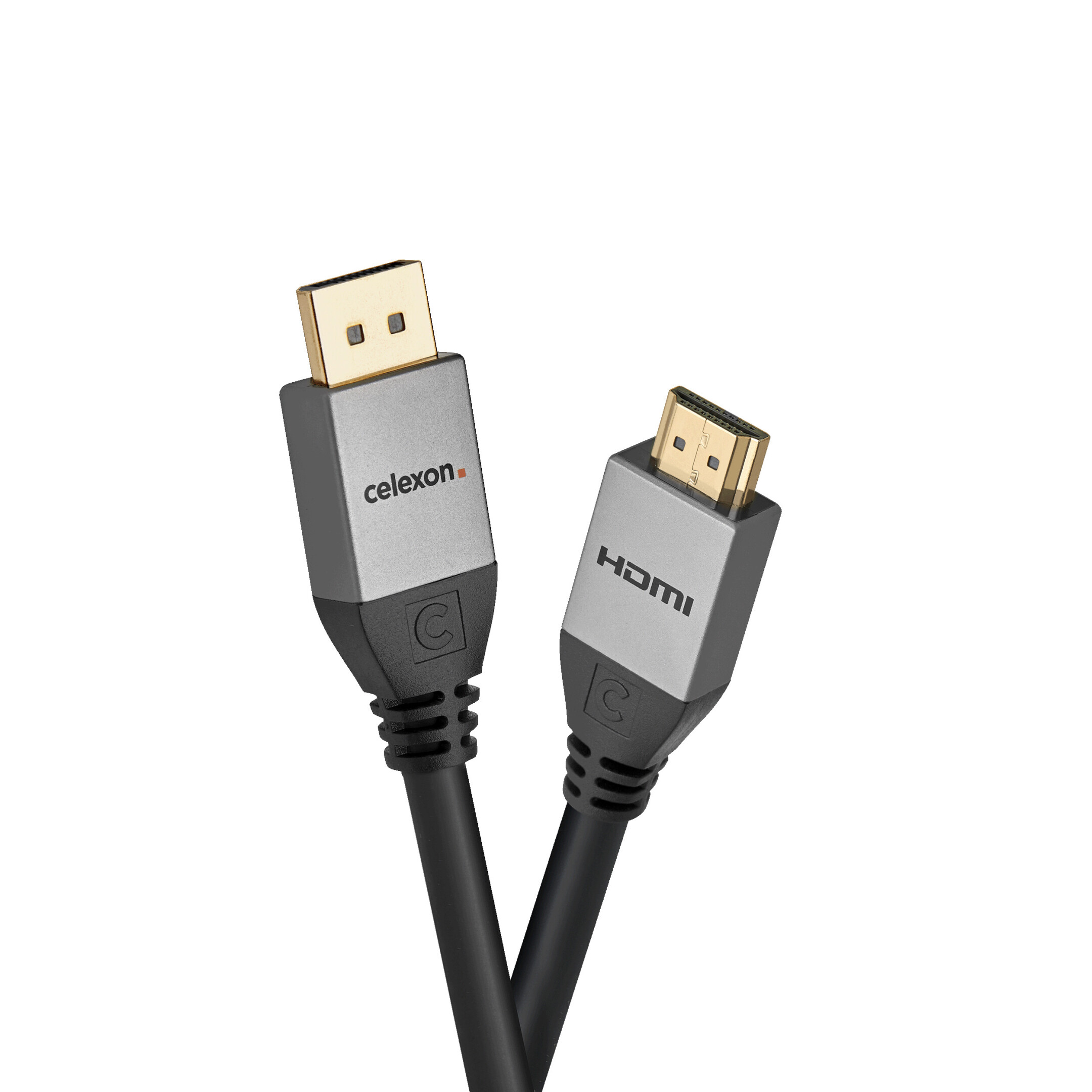



























£15.99*


Product information
The celexon DisplayPort to HDMI cable is DisplayPort version 1.2, as well as HDMI 1.4 compliant and thus transmits signals at up to 10.2Gbps with resolutions up to 4K (4096x2160p @30Hz with 8-bit colour depth). Due to the colour subsampling of 4:4:4, all brightness and image information is transmitted in full sharpness. With the DisplayPort connector on one side and the HDMI connector on the other, it is a cable and adapter at the same time. There is no need for an additional adapter if a DisplayPort socket is to be connected to an HDMI-A socket.
The celexon DisplayPort to HDMI cable is unidirectional. This means that DisplayPort source devices (PC, laptop etc.) can be connected to HDMI output devices (display, projector etc.).
The Multi Stream Transport Mode (MST) makes it possible to operate several monitors via one DisplayPort connection on the PC. There are two different ways to use this feature. Several monitors are connected in series via a daisy chain or the monitors are connected via an additional DisplayPort MST hub.
The number of displays that can be connected via MST depends on the resolution of the individual displays. For example, it is possible to connect 4 displays with a resolution of Full HD (1920x1080p @60Hz).
For daisy-chained displays, each display in the configuration, except for the last display in the chain, must have a DisplayPort receiver and transmitter to send and receive the video stream addressed to itself and the other members of the chain. Once the monitor extracts the video and audio stream addressed to it, it transmits the rest of the video and audio stream along the chain. Each chained monitor must have the full knowledge.
The alternative method to use MST to deploy multiple displays is to use an MST Hub. The MST Hub splits the full bandwidth of a DisplayPort output and allows you to send, for example, 4 independent Full HD signals at 60Hz. The MST Hubs can distribute these video signals (with sound) to the connected screens. Using this type of configuration also allows you to use screens with different inputs.
The DisplayPort cables of the Professional Line are triple shielded and ensure high corrosion resistance and reliable transmission performance thanks to their gold-plated contacts.
celexon's Professional Line combines technically reliable functionality and flawless workmanship with elegant design.
Whether you use our cables for office (home office), entertainment or professional use, you are perfectly connected in all areas.
KEY INFORMATION
- DisplayPort plug to HDMI-A plug
- Standard: DisplayPort version 1.2, HDMI 1.4 compliant
- Transfer rate: 10.2 Gbps
- Max. Resolution: 4K / UltraHD / 4096x2160p @30Hz, 8 Bit, 4:4:4
- Supported colour spaces: 16/24 bit RGB/YUV, Deep Color, x.v.Color.
- Supported audio standards: Dolby Digital Plus, Dolby TrueHD, DTS-HD Master Audio, DVD Audio, SA-CD
- Additional features: MST (multi-stream transport), HDCP, EDID, unidirectional
- Connector: gold-plated contacts, chrome-plated aluminium housing, flexible bend protection
- Cable: high-purity copper conductors, 3-fold shielding, PVC sheath with 7.3 mm diameter
- Cable colour: black
- Cable type: round
- Cable length: 1.5m
- REACH, RoHs compliant
IN THE BOX
- 1x celexon DisplayPort Cable 4K 1.5m - Professional Line
Technical data
| Name | celexon DisplayPort to HDMI cable 4K 1.5m - Professional Line |
|---|---|
| Article number | 1000015550 |
| GTIN/EAN | 4260094743238 |
| Manufacturer SKU | 1000015550 |
| Model name | 1000015550 |
| Brand | celexon |
| Product Type | HDMI cable |
| Product Series | celexon DP to HDMI Professional Line |
| Inputs | 1x Displayport |
| Outputs | 1x HDMI |
| Features | 4K Pass Through |
| Cable length | 1.5 m |
| Product width | 2.3 cm |
| Product height | 1.4 cm |
| Product depth | 150 cm |
| Weight | 0.125 kg |
| Colour | Black |
| Condition | New |
| Warranty | 24 Month |
| Warranty type | Bringin service Service and support information |
Product safety
| Person responsible for the EU |
|---|
| celexon Europe GmbH |
| Gutenbergstraße 2 |
| 48282 Emsdetten |
| Germany |
| info@celexon.de |



